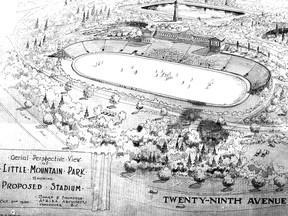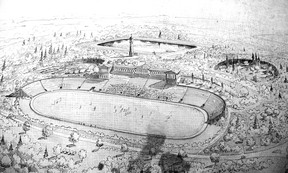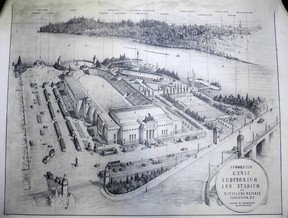The proposal had several variations in Little Mountain and in Kitsilano

.
In 1910, the Canadian Pacific Railway gave Vancouver, South Vancouver, and Point Gray an option to purchase Little Mountain (today’s Queen Elizabeth Park) for a park. South Vancouver and Point Gray were separate municipalities until they joined the City of Vancouver in 1929.
Announcement 2
.
The price: $125,000 for 95 acres. But the cities did not pull the trigger on the deal until Point Gray voters approved it in a plebiscite on September 15, 1928.
For whatever reason, the price had dropped to $100,000 in 18 years. But the CPR seemed happy to make the deal, which would increase the value of the “Little Mountain subdivision” it was developing nearby.
However, to the chagrin of the CPR, local developers soon began touting a sports stadium for the new park. The plan went through two incarnations before finally fading on August 8, 1931, when The Vancouver Sun declared “Deadlock Halts New Stadium”.
The park board wanted to limit seating to 15,000, with all seats on the south side, while the private developers of the $175,000 scheme wanted to build 28,000 seats, including some on the north side. The CPR also insisted that the stadium be 400 feet east of Cambie, which would have meant that the stadium would have had to be built partially over a ravine. With negotiations at an impasse, the project was rejected.
Announcement 3
.
Still, it was almost built: the city allocated money for its construction.

There is an “aerial perspective view” of the stadium in the Vancouver Archives. The design was by Sharp and Thompson, the architects of the Burrard Bridge. It is dated October 2, 1930, and shows a grassy oval with a track and bleachers to the south. In the illustration, people are playing soccer.
The Canadian Olympic Trials Committee was a big supporter of the stadium, and it looks very Olympic, like a miniature version of the Los Angeles Coliseum, which hosted the 1932 Summer Olympics.
The stadium would be located just north of the peak of Little Mountain, carved out of the mountainside above West 29the Avenue. The plan also included an open-air reservoir atop Little Mountain and a tower between the reservoir and the stadium. It looks like a local version of San Francisco’s Coit Tower, which was built around the same time.
Announcement 4
.
When the stadium was announced in the Sun of October 3, 1930, the newspaper said that “plans drawn by Mr. Sharp show a stadium 570 feet long by 290 feet wide with a capacity of 25,000. (But) a later extension is planned to bring the capacity to 50,000.”
Sharp and Thompson had set up a similar stadium on the Kitsilano Indian Reservation (now Vanier Park), but The Sun reported that the province wanted $300,000 for the land, “in addition to the purchase price for the Indians.” So they set their eyes on Little Mountain, which Ald. JJ McRae noted that “it was already owned by the Park Board and it wouldn’t cost the city a dime.”
The Sun reported that the “advantage” of the Little Mountain site is that it was only a 12-minute drive from downtown, and the BC Electric Railway “says it can easily transport 1,000,000 people to the park, if needed.”
ad 5
.
That could have been a typo: Vancouver’s population in 1931 was only 300,000.
Governments were pressured to spend money on public works during the Depression, with the civic, provincial, and federal governments reportedly ready to shell out more than $60,000 to help build the new stadium. The rest would be collected by “public subscription”.
This did not work out, and on March 13, 1931, a Portland, Oregon business group offered to build a $175,000 stadium on Little Mountain at no cost to the city. He proposed to lease the space for $5,000 per year.
This was the proposal that was rejected on August 8. But the Portland group took a turn and proposed building a stadium on land it had acquired in the area about 16the and Trafalgar. Vancouver’s first stadiums were built privately.
Nothing came of it, but Sharp and Thompson’s plan for a stadium on the Kitsilano reservation was brought up again by Mayor Gerry McGeer in 1936. But it wasn’t built, for the second time.


